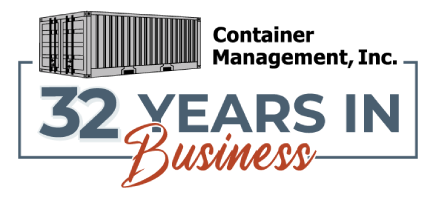Update: U.S. - China Tariffs
Written by Susan Nalevac | May 13, 2025
As one of the leading providers of new and used shipping containers in the US, Container Management, Inc. is committed to transparency in reporting on availability, pricing, and shipping container industry trends. We proactively inform our customers about market factors that may impact inventory levels and pricing. When inventory of goods is disrupted at any part of the supply chain, so are the prices and demands of the shipping container at the heart of it all. The following information is provided as an update to our May 11, 2025 blog posting.
Steamship Lines Adapt to U.S. - China Tariff Pause
Steamship lines are responding swiftly to the recent 90-day U.S.-China tariff pause, which reduced U.S. tariffs on Chinese goods from 145% to 30% and China's tariffs on U.S. goods from 125% to 10%. This temporary relief has prompted several strategic adjustments in the maritime shipping industry.
Surge in Shipping Demand
The tariff reduction has led to a notable increase in shipping activity. For instance, German shipping company Hapag-Lloyd reported a significant uptick in container bookings from China to the U.S. Similarly, freight forwarder Flexport observed a 35% surge in bookings within a single day following the announcement. This rush is driven by businesses aiming to import goods before the tariff pause potentially ends, especially ahead of the peak shipping season from August to October.
Capacity Adjustments and Route Realignments
Major steamship operators are cautiously optimistic, but are taking measured approaches to the tariff pause. After experiencing significant volatility during the trade tensions, many carriers are hesitant to make immediate large-scale adjustments to their capacity or routes.
However, they are reevaluating their capacity allocations. Hapag-Lloyd, which had considered deploying smaller vessels due to previous demand downturns, is now contemplating the use of larger ships to accommodate the surge. Maersk, having previously shifted 20% of its capacity away from the China-U.S. route, is prepared to reallocate resources based on customer needs.
Operational Challenges
Despite the positive momentum, the industry faces several challenges. The sudden spike in demand has led to concerns over ship and container availability, logistical disruptions, and strained warehouse capacities.
Analysts caution that while the tariff pause offers short-term relief, the long-term outlook remains uncertain, especially with the possibility of tariffs returning after the 90-day window
Potential Impacts of Proposed Port Fees
Adding to the complexity, the U.S. Trade Representative has proposed imposing fees of up to $1.5 million per port call on Chinese-built ships. Industry leaders warn that such measures could disrupt trade flows, increase shipping costs, and lead to port congestion. Carriers might respond by reducing services to certain U.S. ports or rerouting vessels, potentially impacting the efficiency of supply chains.
Strategic Shifts in Trade Routes
To mitigate tariff impacts, some shippers are redirecting cargo flows to other countries, such as Vietnam and Mexico. This strategic rerouting has resulted in significant increases in shipping volumes from Asia to Mexico, highlighting Mexico’s growing role in transpacific trade.
Summary
In summary, while the tariff pause has provided temporary relief and boosted shipping activity, steamship lines are navigating a complex landscape of operational challenges and policy uncertainties.The industry's adaptability in reallocating resources and adjusting strategies will be crucial in maintaining supply chain stability during this period. Steamship companies remain concerned about potential reimposition of tariffs, and many are developing contingency plans that would allow quick adaptation if trade tensions resume.
Recommendations for Customers
- Act now: If your business depends on container availability, now is the time to secure stock. Delays could mean paying more — or worse, being unable to source containers at all.
- Build a Relationship with your Container provider: Tariffs may shift again later this year, especially as global trade discussions continue. Businesses that prepare early, build relationships with local suppliers, and move quickly on available stock will be in a stronger position.
- Monitor Pricing: With some suppliers already raising prices, market indicators show that prices are trending to increase as inventory reduces.
- Plan for Longer-Term Disruption: This may not be a short-lived blip. Ongoing trade tensions, tariffs, and logistical hurdles suggest a prolonged period of market volatility.
If you need advice on how to source containers in this environment or want more details on regional impacts, let us know! Call us at 708-639-4992 or visit our website at https://www.containermgt.com
We stock Wind and Watertight units; Used - Cargo Worthy containers, New One-Trip containers, and we have fabrication facilities at some of our locations to customize your containers to meet your specific needs. We provide a professional shipping container delivery service to any home or business site in the US. Our network of transportation companies is one of the best in the industry.





